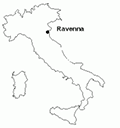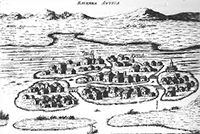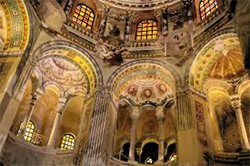Ravenna: Onetime Capital of the Roman Empire
Ravenna is an old city, springing up in ancient times at a location that is now in northeast Italy. Some historians think that the Etruscans founded the city, which was built near a lagoon, much like Venice. Other sources attribute the founding to the Thessalians. 

Ravenna was part of the Roman Republic as early as 89 B.C. It was from that city in 49 B.C. that Julius Caesar marched to cross the Rubicon. The first Emperor, Augustus, ordered a harbor built at nearby Classe and made it one of the two stations of the Roman fleet. Eventually, Classe and Ravenna grew toward each other. The emperor Tiberius encouraged this growth by building a common wall around the two. The emperor Trajan had a 43-mile-long aqueduct built to maintain the viability of fresh water to the area. 
The emperor Honorius moved the imperial capital to Ravenna in 402. Alaric, on his march on Rome seven years later, bypassed Ravenna. When Odoacer deposed the last emperor in the West, Ravenna soldiered on. The subsequent reconquest campaign of the Ostrogoth king Theodoric resulted in the flight of Odoacer to Ravenna, where he withstood a three-year siege. Eventually, Theodoric seized control of the city and killed Odoacer, then declared Ravenna the capital of the Ostrogothic Kingdom of Italy. The largest reconquest, that of the Byzantine Emperor Justinian in the person of the general Belisarius, had Ravenna as its center. During these various occupations, those in power ordered built many iconic churches and other kinds of buildings, some of which, such as the Basilica of San Vitale (left), still stand in some part. Ravenna and its descendants of the Rome-Byzantium power base hung on into the 8th Century, until the Lombards finally took the city, about 750. |
|
Social Studies for Kids
copyright 2002–2026
David White




